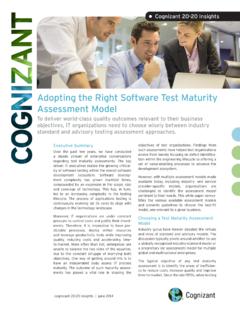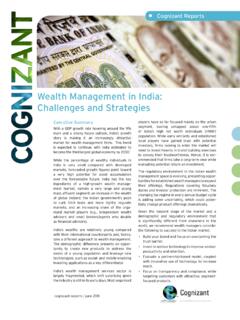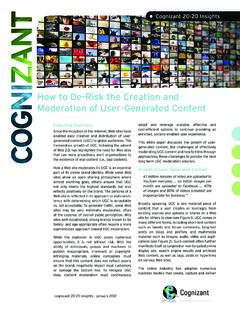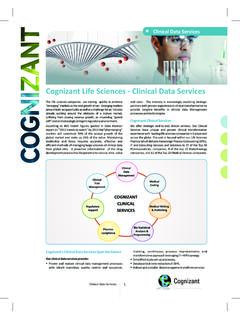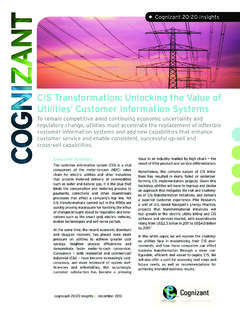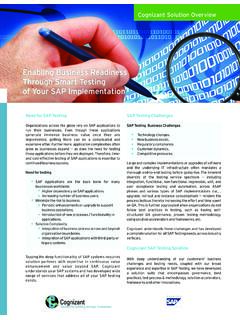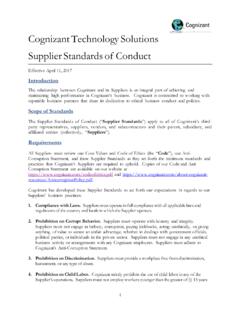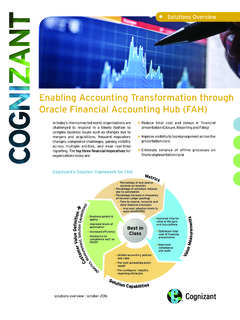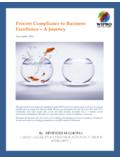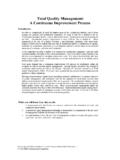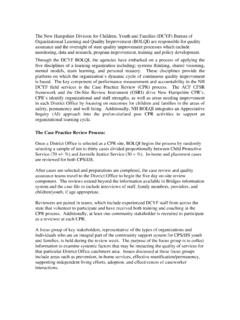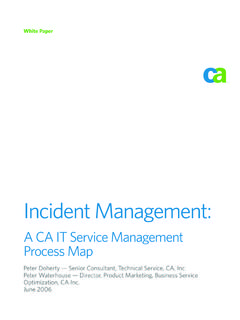Transcription of Top 10 Imperatives for Leading a Successful IT …
1 Top 10 Imperatives for Leading a Successful IT improvement ProgramWhen companies understand the critical success factors for Leading an IT performance and process improvement program, they can advance their business objectives and increase adoption across the SummaryRapid technological advancement ( , cloud, social media, mobile and analytics) and increased globalization are having a profound impact on the IT operating IT organizations are struggling to improve their operating perfor-mance in response to market demands for lower costs, higher quality services, shorter response times and higher return on investments. Many IT organizations are applying quality improvements pioneered and perfected in the manufacturing sector to drive organizational per-formance and process excellence.
2 Although most organizations clearly understand the benefits, it has traditionally been a struggle to successfully implement IT organizational performance and process improvements, even for top-performing companies. This paper presents solutions and best practices for mitigating challenges and success-fully deploying such initiatives. Based on our experience assisting Fortune 1000 clients with large IT organizational performance and process improvement programs, we believe there are 10 key implementation Imperatives : 1. Obtain senior leadership commitment to initiating and managing IT organizational performance and process improvement Perform an objective assessment, leverag-ing standard models, for defining realistic improvement goals.
3 3. Focus on identifying the right processes and their process owners to achieve the established Develop a roadmap that is well understood and accepted by the identified process owners. 5. Institute a targeted marketing strategy that creates enthusiasm and greater Establish a governance model that enables effective management of the Develop processes that are standard and fit to use. 8. Facilitate organizational change management to ensure smooth implementa-tion of the recommended Enable effective benefit tracking and reporting to ensure sustained top-manage-ment support. Cognizant 20-20 Insightscognizant 20-20 insights | may 2012cognizant 20-20 insights210. Focus on continuous improvement of the IT organizational performance and process New IT Mandate Several technology trends are building the case for enhancing IT performance, including exter-nalized service delivery, global market demand, increased data volumes, social media explosion, IT in business shared services and increased complexity of the IT ecosystem (see Figure 2, next page).
4 Overcoming these challenges will help the IT organization increase its agility and respon-siveness to business organizations are responding to these trends by adopting effective IT operating models (see Figure 3, page 4). The building blocks for any IT operating model organization, process and technology are undergoing a radical rethink to ensure tight alignment to meet the demands of the aforementioned trends. To improve their IT operating model, companies are increasingly adopting IT performance and process improvement initiatives based on indus-try-standard frameworks such as CMMI, ITIL, COBIT, Lean, etc. to support and drive changes to their IT organizational functions or technologies. The next section describes how to effectively lay out the vision of such initiatives, as well as effec-tively manage the implementation journey for achieving desired goals and 10 Imperatives for IT Improvement1.
5 Obtain senior leadership commitment to initiating and managing IT organizational performance and process improvement Challenges IT organizational performance and process improvements require sustained effort and commitment across all levels of the organization. The morale of employees and their involvement in the improvement initiative is directly related to CIO/top management commitment and clarity of Recommendations Based on our experience, IT organizational per-formance and process improvements that have been driven or sponsored by the highest levels in the organization are more likely to succeed. We advised one of our clients to include improvement goals and objectives as part of the company s CIO performance targets and cascade them down to various departmental leaders.
6 This strategy resulted in increased commitment from all 10 Imperatives for IT improvement ProgramsFigure 1 Goal settingExecutionCIO/top management commitment (required across the program)Program ManagementProgram governanceProgram change managementProgram marketingContinuous improvement12347956810 process identificationRoadmap creationBenefit realizationcognizant 20-20 insights32. Perform an objective assessment, leveraging standard models, for defining realistic improvement goals. Key ChallengesIt has been a challenge to establish appropriate goals and objectives for an IT organizational per-formance and process improvement initiative. Various organizations have struggled to set realistic goals based on change management considerations.
7 Key Recommendations IT organizational performance and process improvements should focus on every aspect of the IT value chain (as described in Figure 4, page 5) and set up realistic goals that reflect the orga-nizational appetite for the change. There are several industry-standard assessment models ( , CMMI, ITIL, the Gartner IT maturity model,2 etc.) that could help chart out an improvement roadmap. The two forms of assessment methods seen in the industry are formal third-party assessments and self-assessments. The choice of a maturity model and assessment methodology will depend on the focus of the improvement initiative ( , CMM/CMMI is more focused on software processes, while ITIL is aimed at operations), organizational relevance and cost considerations.
8 It typically takes 18 to 36 months to transition from one level to the next. We helped one of our large insurance clients define and manage a com-prehensive two-year roadmap to transition from Level 2 to Level 3 on Gartner s IT maturity model (see sidebar, page 8). 3. Focus on identifying the right processes and their process owners to achieve the established ChallengesBased on the maturity assessment, once the organization is made aware of areas for improve-ment, the next challenge is to identify process areas with high impact and associate them with the right process owners. Key RecommendationsA software engineering process group (SEPG)3 or dedicated cross-functional team respon-sible for driving the performance and process improvement initiative should lead the exercise of identifying process areas for improvement and associating them with the right process owners.
9 This should be conducted via a series of program definition workshops involving key stakeholders from each of the IT functional areas. Based on our experience of implementing such programs, the appropriate process owner should be someone who is involved with many aspects of the process . When there are multiple entities using a process equally, then it is best to assign the process governance or ownership to a broader Drivers for Improving IT Organizational and process PerformanceFigure 2 Externalized service delivery: IT organizations are increasingly leveraging cloud-based or software as a service (SaaS) delivery models, resulting in significant IT operating model market demand: Business from emerging markets is growing significantly, mandating diverse IT models for supporting business data volumes: Emerging use of mobile devices is driving a need for enhanced data management to support the exponential growth in data media explosion.
10 Social media has enhanced customer and employee interaction with the organization by providing an easy-to-use in business shared services: Centrally provided applications and infrastructure are being embedded in business services and delivered by business shared complexity of the IT ecosystem: Significant customization and proliferation of IT assets has increased the complexity of the IT 20-20 insights4process management entity ( , SEPG). The process owner should be sufficiently senior in the organization to drive the change. It is imperative to identify the right process owner with adequate empowerment and interest in driving the change. 4. Develop a roadmap that is well understood and accepted by the identified process owners.
